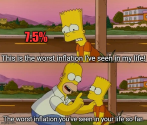The trigger for MMT's launch to notoriety was the "Green New Deal," an environmental project for the United States created by the more progressive wing of the Democratic Party.
The pledges include, in addition to more spending for environmental protection (which includes, without exaggeration, the abolition of air travel), a renewal of infrastructure, full employment, "free" public health for all and, above all, the promise of a monthly income for all those who "don't want" to work (note: it's not just for those who "can't" or "can't" work, but also those who just aren't willing to work)
The promoters of this project cited Modern Monetary Theory as the framework that allows all these sublime desires to magically become practical. In other words, TMM would be the elixir that will finance this entire public spending plan.
The points that TMM defends
MMT maintains that the government can spend freely, and that large deficits and public debts do not matter when the economy is not at full capacity.
It also claims that the state, as the sovereign issuer of currency, cannot go bankrupt because it creates money whenever it spends. Insufficient saving does not constrain public spending, as budget deficits automatically have private savings as a counterpart.
Representatives of this theory claim that the issuer of the country's currency cannot go bankrupt because the sovereign state can always create as much money as it needs to honor its debt. The function of taxation is not to "earn revenue" for the government, but rather to be an instrument to force the public to use sovereign currency as money (according to the theory, currency acceptance stems from the fact that it can be used to pay taxes). Additionally, taxation would also have the function of withdrawing money from the economy when it became excessive and began to put pressure on prices.
In other words, currency is debt and not primarily a medium of exchange. MMT's logic says that since the government creates money from its own spending, taxation is not necessary to finance state activity. The main function of taxation is to motivate the use of the national currency and obtain its general acceptance, because it is this unit of account that the state recognizes as a means of paying taxes. In addition, taxation has a regulatory function to divert excess demand and modify individual behavior.
All public spending can be financed either by direct printing of money or by borrowing from the government, as government bonds are only as good as the currency the sovereign state issues. The state, therefore, can issue debt and then print money to pay off this debt.
Public debt, moreover, is not a problem, as it represents "financial wealth in the private sector", which invests in it. Therefore, public sector spending not only does not absorb savings, but, on the contrary, generates income for the private sector. Government spending and budget deficits do not lead to lower private investment and do not require a higher tax burden in the future. The government is free from any fiscal constraint because it can always create as much money as it needs.
For all these reasons, the government should not conduct its finances like a family, which needs income before spending. A government that issues fiat money as the legal tender of a country does not need taxes and borrowing to spend.
"Deficits don't matter" is the fundamental mantra of Modern Monetary Theory. Budget deficits do not pose a problem for the performance of the economy when there is supposedly unused economic capacity. On the contrary: they are beneficial. As public spending leads to money creation, it itself creates the savings needed to finance the budget deficit. Consequently, the government (or its Central Bank) can set the interest rate at any level it wants, preferably at zero.
The true meaning of all this is the belief that scarcity does not exist.
For MMT promoters, the national debt is not debt in the conventional sense, but represents the accumulated deficits of the past and, as such, is a record of the net amount of currency that the federal government has created over time. Understanding this power of money creation means abandoning the restrictions of debt ceilings and renouncing the requirement for a balanced budget. Adopting this view would free government from false restrictions and pave the way for full prosperity.
Freed from the shackles of financial restraint, the federal government could restore the country's infrastructure, invest in health and education, guarantee internal and external security, guarantee wages for those who do not want to work, and, at the same time, solve the social security problem.
The utopian vision says that, with the application of Modern Monetary Theory, any nation would reach full employment and end up with poverty.
Want a practical example of this theory from the last century?



